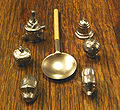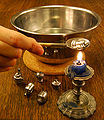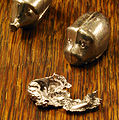- Molybdomancy
-
Molybdomancy is a technique of divination using molten metal. Typically molten lead or tin is dropped into water.
The method was invented in ancient Greece,[1] and today it is a common New Year tradition in the Nordic countries and Germany. Classically, tin is melted on a stove and poured into a bucket of cold water. The resulting shape is then rotated in a candlelight to create shadows, whose shapes are then interpreted.
In Finland, shops sell ladles and small bullions in the shape of a horseshoe for this express purpose. Originally made from tin, now they are made from cheaper low-melting alloys based on lead. The practice is known as uudenvuodentina; .[2] World's largest uudenvuodentina, 41 kg, was cast by members of the Valko volunteer fire department in Loviisa, Finland in New Year 2010.[3][4]
The shapes are often interpreted not only literally, but also symbolically: a bubbly surface refers to money, a fragile or broken shape misfortune. Ships refer to travelling, keys to career advancement, a basket: a good mushroom year, and a horse: a new car.[5]
References
- de Givry, Grillot (1931). Witchcraft, magic & alchemy. Courier Dover Publications. p. 303. ISBN 0486224937.
- Cosman, Madeleine Pelner; Jones, Linda Gale. Handbook to life in the medieval world. Infobase Publishing. p. 434. ISBN 0816048878.

This spirituality-related article is a stub. You can help Wikipedia by expanding it.



